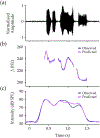Prediction of Voice Fundamental Frequency and Intensity from Surface Electromyographic Signals of the Face and Neck
- PMID: 36299552
- PMCID: PMC9592063
- DOI: 10.3390/vibration5040041
Prediction of Voice Fundamental Frequency and Intensity from Surface Electromyographic Signals of the Face and Neck
Abstract
Silent speech interfaces (SSIs) enable speech recognition and synthesis in the absence of an acoustic signal. Yet, the archetypal SSI fails to convey the expressive attributes of prosody such as pitch and loudness, leading to lexical ambiguities. The aim of this study was to determine the efficacy of using surface electromyography (sEMG) as an approach for predicting continuous acoustic estimates of prosody. Ten participants performed a series of vocal tasks including sustained vowels, phrases, and monologues while acoustic data was recorded simultaneously with sEMG activity from muscles of the face and neck. A battery of time-, frequency-, and cepstral-domain features extracted from the sEMG signals were used to train deep regression neural networks to predict fundamental frequency and intensity contours from the acoustic signals. We achieved an average accuracy of 0.01 ST and precision of 0.56 ST for the estimation of fundamental frequency, and an average accuracy of 0.21 dB SPL and precision of 3.25 dB SPL for the estimation of intensity. This work highlights the importance of using sEMG as an alternative means of detecting prosody and shows promise for improving SSIs in future development.
Keywords: EMG; fundamental frequency; intensity; loudness; pitch; speech; voice.
Conflict of interest statement
Conflicts of Interest: J.M.V., C.L.M., L.R., G.D.L. and J.C.K. are employed by Delsys, Inc., a commercial company that manufactures and markets sensor and software technologies for human movement, and Altec, Inc., an R&D company that performs research to reimagine human potential.
Figures




References
-
- Keszte J; Danker H; Dietz A; Meister EF; Pabst F; Vogel H-J; Meyer A; Singer S Mental disorders and psychosocial support during the first year after total laryngectomy: A prospective cohort study. Clin. Otolaryngol 2013, 38, 494–501. - PubMed
-
- Terrell JE; Fisher SG; Wolf GT Long-term Quality of Life After Treatment of Laryngeal Cancer. Arch. Otolaryngol. Head Neck Surg 1998, 124, 964–971. - PubMed
-
- Bickford JM; Coveney J; Baker J; Hersh D Self-expression and identity after total laryngectomy: Implications for support. Psycho-Oncology 2018, 27, 2638–2644. - PubMed
-
- Lúcio GDS; Perilo TVDC; Vicente LCC; Friche AADL The impact of speech disorders quality of life: A questionnaire proposal. CoDAS 2013, 25, 610–613. - PubMed
-
- Garcia SM; Weaver K; Moskowitz GB; Darley JM Crowded minds: The implicit bystander effect. J. Pers. Soc. Psychol 2002, 83, 843–853. - PubMed
Grants and funding
LinkOut - more resources
Full Text Sources
Miscellaneous
